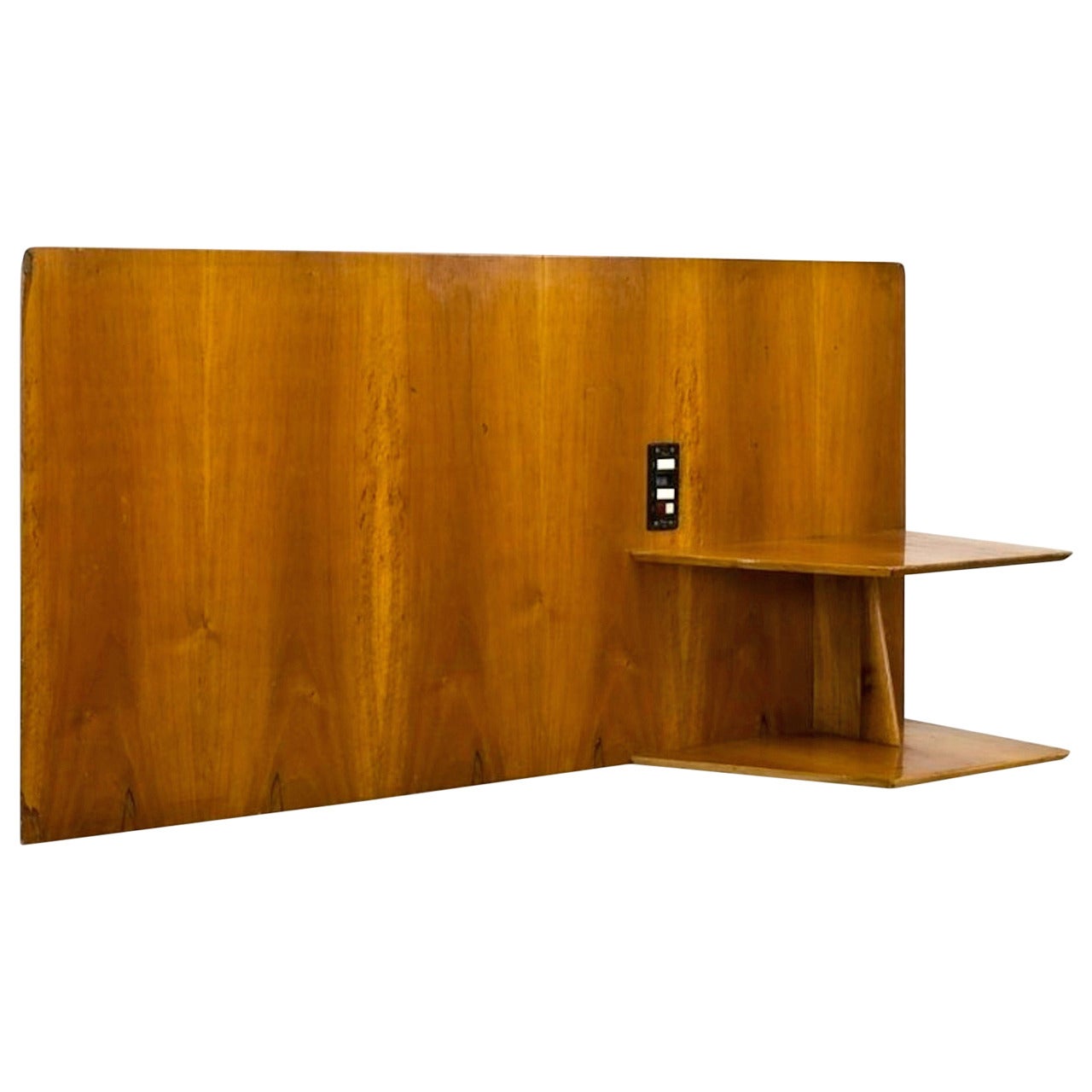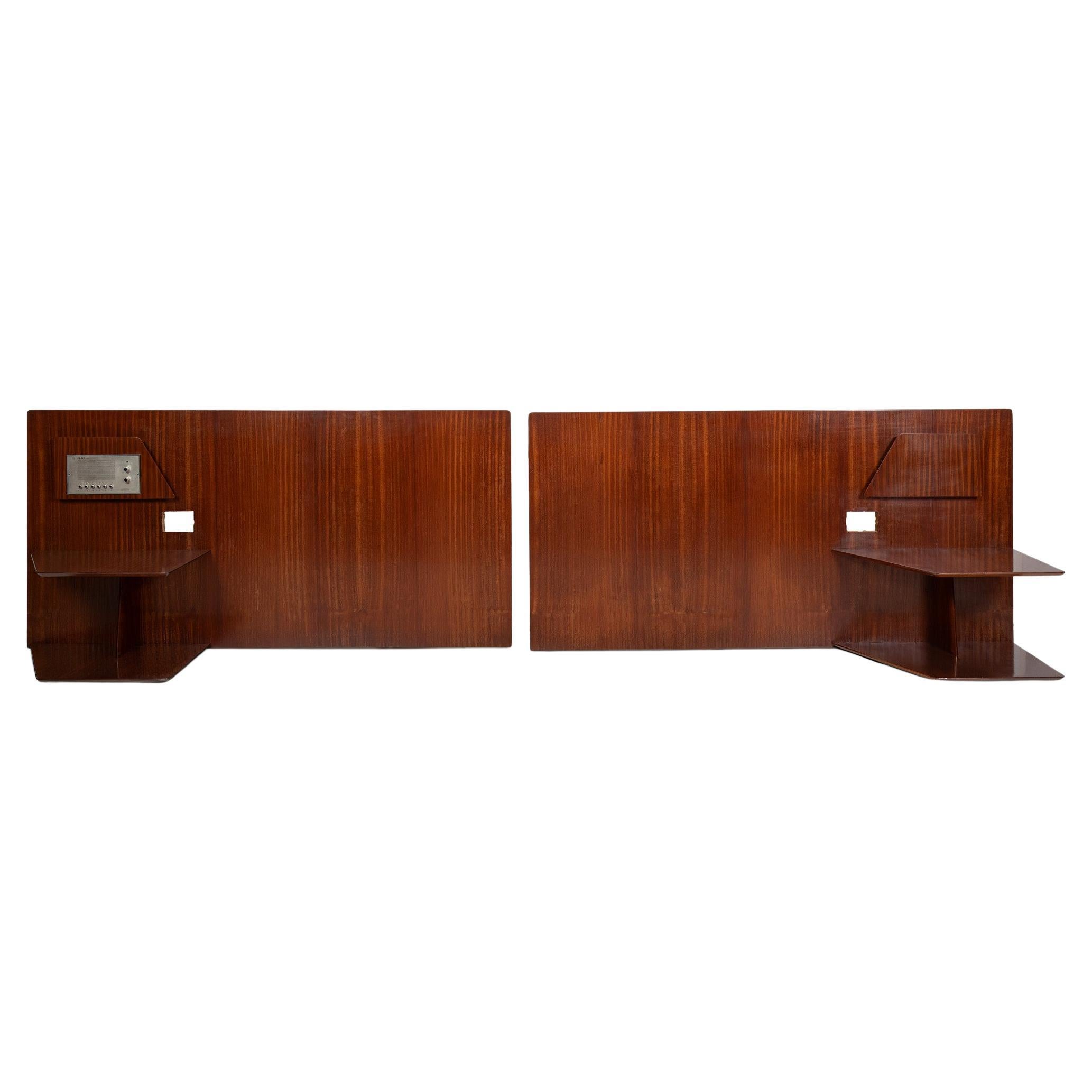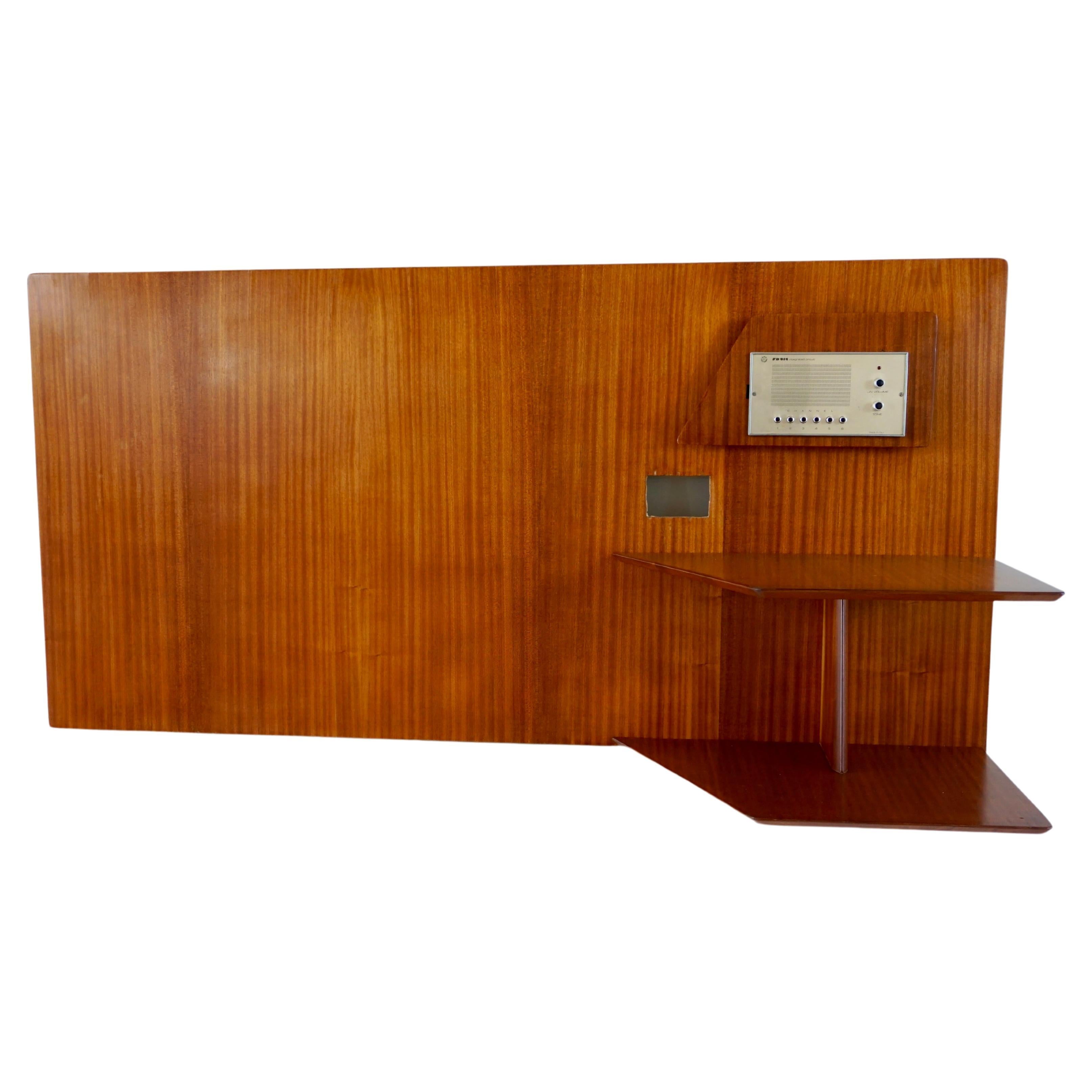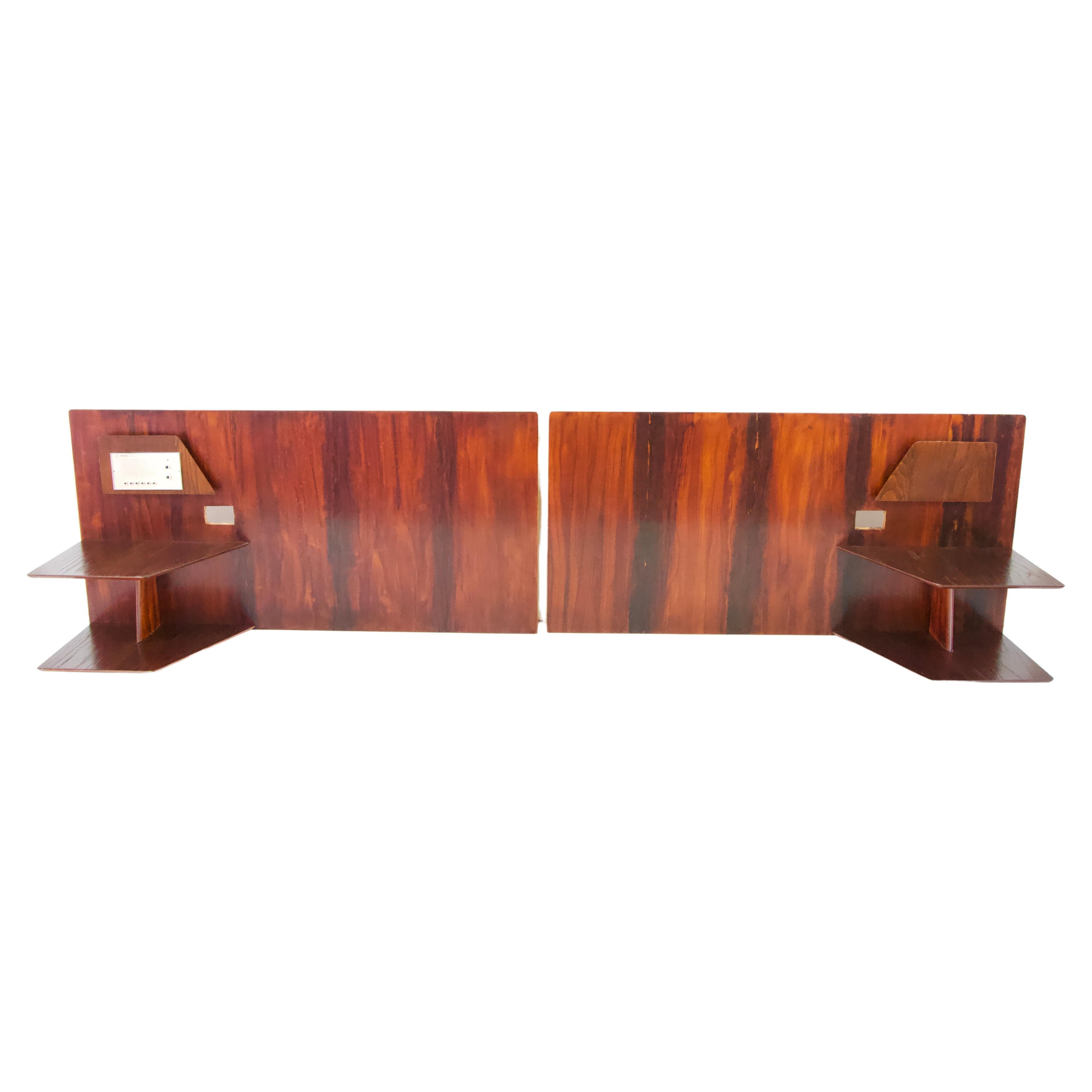Gio Ponti Headboard and Bedframe with Attached Nightstands
About the Item
- Creator:Gio Ponti (Designer),Giordano Chiesa (Manufacturer)
- Dimensions:Height: 49.25 in (125.1 cm)Width: 127 in (322.58 cm)Depth: 86 in (218.44 cm)
- Style:Mid-Century Modern (Of the Period)
- Materials and Techniques:
- Place of Origin:
- Period:
- Date of Manufacture:1950s
- Condition:Refinished. Reupholstered. Wear consistent with age and use. Excellent restored condition; new velvet upholstery.
- Seller Location:Los Angeles, CA
- Reference Number:1stDibs: LU1645232656252
Gio Ponti
An architect, furniture and industrial designer and editor, Gio Ponti was arguably the most influential figure in 20th-century Italian modernism.
Ponti designed thousands of furnishings and products — from cabinets, mirrors and chairs to ceramics and coffeemakers — and his buildings, including the brawny Pirelli Tower (1956) in his native Milan, and the castle-like Denver Art Museum (1971), were erected in 14 countries. Through Domus, the magazine he founded in 1928, Ponti brought attention to virtually every significant movement and creator in the spheres of modern art and design.
The questing intelligence Ponti brought to Domus is reflected in his work: as protean as he was prolific, Ponti’s style can’t be pegged to a specific genre.
In the 1920s, as artistic director for the Tuscan porcelain maker Richard Ginori, he fused old and new; his ceramic forms were modern, but decorated with motifs from Roman antiquity. In pre-war Italy, modernist design was encouraged, and after the conflict, Ponti — along with designers such as Carlo Mollino, Franco Albini, Marco Zanuso — found a receptive audience for their novel, idiosyncratic work. Ponti’s typical furniture forms from the period, such as the wedge-shaped Distex chair, are simple, gently angular, and colorful; equally elegant and functional. In the 1960s and ’70s, Ponti’s style evolved again as he explored biomorphic shapes, and embraced the expressive, experimental designs of Ettore Sottsass Jr., Joe Colombo and others.
Ponti's signature furniture piece — the one by which he is represented in the collections of the Museum of Modern Art in New York, Germany’s Vitra Design Museum and elsewhere — is the sleek Superleggera chair, produced by Cassina starting in 1957. (The name translates as “superlightweight” — advertisements featured a model lifting it with one finger.)
Ponti had a playful side, best shown in a collaboration he began in the late 1940s with the graphic artist Piero Fornasetti. Ponti furnishings were decorated with bright finishes and Fornasetti's whimsical lithographic transfer prints of things such as butterflies, birds or flowers; the Montreal Museum of Fine Arts possesses a 1950 secretary from their Architetturra series, which feature case pieces covered in images of building interiors and facades. The grandest project Ponti and Fornasetti undertook, however, lies on the floor of the Atlantic Ocean: the interiors of the luxury liner Andrea Doria, which sank in 1956.
Widely praised retrospectives at the Queens Museum of Art in 2001 and at the Design Museum London in 2002 sparked a renewed interest in Ponti among modern design aficionados. (Marco Romanelli’s monograph, which was written for the London show, offers a fine overview of Ponti’s work.) Today, a wide array of Ponti’s designs are snapped up by savvy collectors who want to give their homes a touch of Italian panache and effortless chic.
Find a range of vintage Gio Ponti desks, dining chairs, coffee tables and other furniture on 1stDibs.
Giordano Chiesa
As a master cabinetmaker and furniture craftsman, Giordano Chiesa produced beautiful mid-century modern pieces, largely in collaboration with Italian starchitect and designer Gio Ponti.
Although the pair had a long history of collaboration, their work for stylish mid-century Italian hotels stands out. In the mid-1950s, Ponti and Chiesa teamed up with manufacturer Dassi Lissone to create streamlined walnut and brass furniture for the Royal Hotel in Naples, including headboards, side tables and wardrobe doors for each room. A decade later, the duo designed sleek, blue formica-surfaced ashwood writing desks, dressers and headboards, for the Hotel Parco dei Principi in Rome.
Chiesa produced Ponti’s sculptural glass-topped coffee table, which features artistically aligned maple legs and slats to form a sort of grid as its base. Similar to Ponti’s no. 1101 coffee table for Singer and Sons, Chiesa and Ponti’s table rivals the more famous design in its eloquence and craftsmanship.
On 1stDibs, find a collection of Giordano Chiesa tables, storage case pieces and other furniture and collectibles.
- ShippingRetrieving quote...Ships From: Los Angeles, CA
- Return PolicyThis item cannot be returned.
- Custom American Walnut King Headboard with NightstandsLocated in Los Angeles, CAAmerican made king size headboard with nightstands. This custom king size walnut headboard features clean geometric lines with nigh...Category
Mid-20th Century American Mid-Century Modern Beds and Bed Frames
MaterialsWalnut
- Paolo Piva 'Alanda' Queen Bed with Attached Nightstands for B&B ItaliaBy Paolo Piva, B&B ItaliaLocated in Los Angeles, CAThis postmodern Queen size bed is part of Paolo Piva's 'Alanda' collection for B&B Italia, c.1980s. The bed frame is covered in beautiful topstitched plush leather with an upholstere...Category
Vintage 1980s Italian Post-Modern Beds and Bed Frames
MaterialsLeather, Upholstery, Lacquer
- Kipp Stewart King Size Headboard with Storage for Drexel DeclarationBy Drexel, Kipp StewartLocated in Los Angeles, CAWalnut headboard by Kipp Stewart, for Drexel Declaration c.1960s, USA. This walnut headboard features a shelf along the back with sliding doors for storage. The doors can be closed a...Category
Vintage 1960s American Mid-Century Modern Beds and Bed Frames
MaterialsWalnut
- Edmond J. Spence Full Size HeadboardBy Edmond J. SpenceLocated in Los Angeles, CAMaple full size headboard by Edmond Spence, c.1950s, Sweden. This frame made from solid maple and features a tiered design with squared corners. Dimensions 54.5" width x 2.5" depth ...Category
Vintage 1950s Swedish Scandinavian Modern Beds and Bed Frames
MaterialsMaple
- Folke Ohlsson Full Size Headboard for DUXBy Folke Ohlsson, Dux of SwedenLocated in Los Angeles, CATeak headboard by Folke Ohlsson, circa.1960s for DUX of Sweden. This piece made from solid teak features a spindle detail and soft rounded corners. Dimensions 54" width x 1.5" de...Category
Mid-20th Century Swedish Mid-Century Modern Beds and Bed Frames
MaterialsTeak
- Gio Ponti Style Expanded Metal Shopping BagBy Gio PontiLocated in Los Angeles, CADecorative expanded metal "shopping bag" with handles in the style of Gio Ponti. This piece features age appropriate patina. It would be a great décor p...Category
Mid-20th Century Unknown Mid-Century Modern Decorative Baskets
MaterialsMetal
- Gio Ponti Headboard from Hotel Royal, NapoliBy Gio Ponti, Giordano ChiesaLocated in Hanover, MAA single wall mounted headboard with floating two-tiered nightstand shelves, designed by Gio Ponti in 1955 for the Hotel Royal in Naples. Pro...Category
Vintage 1950s Italian Mid-Century Modern Beds and Bed Frames
MaterialsWalnut
- Gio Ponti, pair Walnut Headboards with fitted bedside tables, Hotel Royal, 1955By Gio Ponti, Giordano ChiesaLocated in Rome, ITA pair of headboards by Gio Ponti from the furniture of the Hotel Royal in Naples, 1955. Manufactured by Giordano Chiesa by Dassi. walnut and metal two tiered shelving, magazine rac...Category
Vintage 1950s Italian Mid-Century Modern Beds and Bed Frames
MaterialsMetal
- Gio Ponti dark wood right Headboard with fitted bedside tables Hotel Royal, 1955By Gio Ponti, Giordano ChiesaLocated in Rome, ITa single left headboard by Gio Ponti from the furniture of the Hotel Royal in Naples, 1955. Manufactured by Giordano Chiesa by Dassi. dark honey wood two tiered shelving, magazine rack, space for lighting switch Good condition. Original patina, Sold with a copy of a certificate of Lisa Licitra Ponti and the original invoice of the Hotel Royal. Directly from the original furniture of the Royal Hotel. Measures: H 80 cm 162 x 44cm each piece; radio of the time; hole for the electrical outlet: cm.10 x h 7 cm Similar items of our same collections have been exhibited in London in Modern Design Museum and Triennale in Milan and a similar items of same collector is now in the permanent collection of the TRIENNALE of Milan. See a pair of heaboards of our collection sold in last Italian Design Auction...Category
Vintage 1950s Italian Mid-Century Modern Beds and Bed Frames
MaterialsMetal
- Gio Ponti Single Elm Left Headboard with fitted bedside table, Hotel Royal, 1955By Gio Ponti, Giordano ChiesaLocated in Rome, ITa single left headboard by Gio Ponti from the furniture of the Hotel Royal in Naples, 1955. Manufactured by Giordano Chiesa by Dassi. olm two tiered shelving, magazine rack, space for lighting switch Good condition. Original patina, Sold with a copy of a certificate of Lisa Licitra Ponti and the original invoice of the Hotel Royal. Directly from the original furniture of the Royal Hotel. Measures: H 80 cm 162 x 44cm each piece; hole for the electrical outlet: cm.10 x h 7 cm Similar items of our same collections have been exhibited in London in Modern Design Museum and Triennale in Milan and a similar items of same collector is now in the permanent collection of the TRIENNALE of Milan. See a pair of heaboards of our collection sold in last Italian Design Auction...Category
Vintage 1950s Italian Mid-Century Modern Beds and Bed Frames
MaterialsElm
- Gio Ponti, pair flamed wood Headboard, fitted bedside tables, Hotel Royal, 1955By Giordano Chiesa, Gio PontiLocated in Rome, ITA pair of headboards by Gio Ponti from the furniture of the Hotel Royal in Naples, 1955. Manufactured by Giordano Chiesa by Dassi. flamed walnut, finish mahogany and metal two tiere...Category
Vintage 1950s Italian Mid-Century Modern Beds and Bed Frames
MaterialsMetal
- Heywood Wakefield Full Size Headboard with Attached Tambour NightstandsBy Heywood-Wakefield Co.Located in Brooklyn, NYFor your consideration is this Mid Century Modern Heywood Wakefield full size headboard with tambour doors attached nightstands. This solid wood...Category
Mid-20th Century American Mid-Century Modern Beds and Bed Frames
MaterialsMaple
Recently Viewed
View AllRead More
Barnaba Fornasetti’s Hallucinatory House Has His Father’s Spirit
Behind a nondescript facade in northeastern Milan is the magical residence of Barnaba Fornasetti. It's a shrine to the style developed by his design-legend father, which still defies categorization.
Billy Cotton Layers His Interiors with Lived-In Comfort
The Brooklyn-based designer is adept at styles ranging from austere to over-the-top, espousing an architectural, detail-oriented approach also evident in his line of furniture and lighting.







